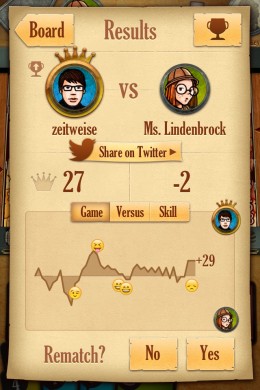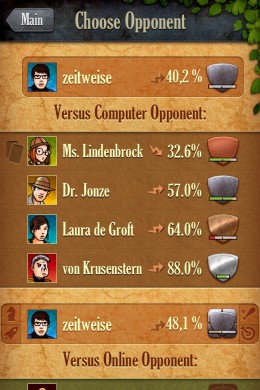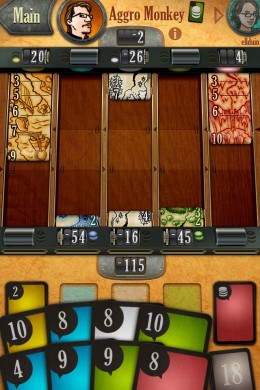 Lost Cities ($1.99) is a game that’s hard to quantify. It’s built on Reiner Knizia’s formidable game design talents, and made into an impressive asynchronous experience by The Coding Monkeys, developers of board game delight Carcassonne ($4.99). It has a robust single-player campaign and most of the online tools one could hope for. It looks great, too. All of that sounds pretty glowing, but we’re only a few days in and I’m already making excuses not to take my turns.
Lost Cities ($1.99) is a game that’s hard to quantify. It’s built on Reiner Knizia’s formidable game design talents, and made into an impressive asynchronous experience by The Coding Monkeys, developers of board game delight Carcassonne ($4.99). It has a robust single-player campaign and most of the online tools one could hope for. It looks great, too. All of that sounds pretty glowing, but we’re only a few days in and I’m already making excuses not to take my turns.
Lost Cities is, more or less, two-player Solitaire. Like Solitaire it’s almost, but not entirely, mindless. You draw cards into your hand, and you put them in appropriately ordered and colored piles. You share the deck with an opponent, and ideally work against each other. Much like Solitaire, though, the game relies on luck as much as skill or strategy. It’s also best played as a time-waster, without the brunt of your full attention. That zen-like state that comes from moving cards around towards a goal is kind of hard to achieve when you’re only taking turns every hour or two.
That’s not to say it’s poorly designed—not at all. It’s just a bit dull for an asynchronous multiplayer game. You take your turn, you place one card, you draw one card. Rinse and repeat. Normally I’d pad out the experience contemplating future moves or considering my opponent’s strategy, but Lost Cities isn’t really complex enough to make much of that necessary.
You start with five lanes, representing lost cities to explore, and ten cards, representing potential profitable discoveries. The cards are numbered 2 – 10 in colors that match the lanes. You can only place cards in ascending order, and only in the appropriate lanes. When you start a lane, your score drops by 20 points (the cost of the expedition), adjusted by the value of the card you placed.
The basic strategy, then, is to only start lanes when you’re pretty sure you can earn at least 20 points with them. You want to start low, because while, say, a nine and a ten will get you most of the way there, you won’t be able to put any cards down after the ten hits. Your opponent will be doing the same thing from the same pool of cards, so you can try to stymie them by hoarding or using the cards they need.
That’s most of the game right there. Each player aims to earn more points than the other, and weighs risks and rewards suitably. You can spice things up by using cards that multiply the losses and gains in your side of a given lane, and you have to weigh some difficult choices when deciding to keep a card or discard it, potentially into your opponent’s hands. These are good, sensible rules, but they don’t change the fact that the end of every game looks basically the same. There are no real surprises in store—you make your calls, and you live and die by the cards you draw after that.
While it can be frustrating to wait while that all plays out asynchronously, it’s much more tolerable in real time. With a player you can trust to play near-live, it can be a fun, quick card game fix. The Coding Monkeys built in a generous amount of stat tracking and Game Center-based challenges to give a sense of ongoing progress. The single-player mode feeds into that as well, with four computer opponents to hone your skills against. Playing the AI is also a great way to get into the flow that games like this thrive on.
Lost Cities probably won’t have the kind of staying power of Carcassone or other asynchronous classics like Words With Friends. No matter how different the results, every game feels pretty much the same, and that really cripples its long-term appeal. It’s not a bad game, though. The Coding Monkeys made beautiful work of bringing it to the small screen, packing it with smart features on top of its already clever design. So there are games out there you might play longer—does that mean this one isn’t worth playing at all?




